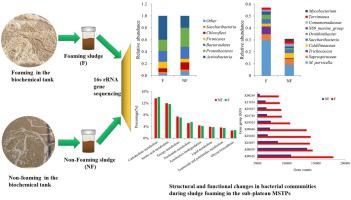Journal of Water Process Engineering ( IF 6.3 ) Pub Date : 2021-04-02 , DOI: 10.1016/j.jwpe.2021.102047 Xiao-Hu Kang , Yong-qiang Tian , Yan Leng , Hui Wang , Shi-Weng Li

|
Sludge foaming has been a persistent ailment in worldwide municipal sewage treatment plants (MSTPs). In particular, this problem frequently occurs and lasts throughout the winter and spring season in the sub-plateau MSTPs. Aims to explore the causes of sludge foaming under sub-plateau circumstance, the correlation between the structural and functional changes in bacterial communities and sewage properties was conducted using Illumina high-throughput sequencing technology. The results from 16S rRNA gene sequencing shown that the relative abundances of Actinobacteria (39.5 % ± 4.8 %) and Firmicutes (10.5 % ± 1.0 %) in the foaming sludge were remarkably higher than that in the non-foaming sludge. The abundances of Candidatus Microthrix parvicella (29.8 % ± 6.9 %), Trichococcus (6.5 % ± 1.0 %), and Ornithinibacter (3.5 % ± 0.6 %) were increased after sludge foaming, and which are considered as the dominated foaming-causative bacterial assemblages by the linear discriminant analysis (LDA). Spearman’s correlation analysis and redundancy analysis (RDA) also agreed that lower temperature and dissolved oxygen (DO) levels, higher lipid and protein contents were significantly correlated with sludge foaming. In addition, the predictive functional profiling indicated that the enzymes and their coding genes of the bacterial communities are mainly involved in the fast proliferation and lipid metabolism, and which abundance are highly upregulated during foaming period. These results suggested that the sludge foaming was strongly linked to the Actinobacteria and Firmicutes communities and higher lipid and protein content in the sewage under sub-plateau circumstance. The findings might be important for developing operating strategies to maintain the desired microbial community pattern and improve the performance of MSTPs.
中文翻译:

亚高原MSTP污泥泡沫化过程中细菌群落的结构和功能变化
污泥起泡一直是世界范围内市政污水处理厂(MSTP)的顽疾。特别是,这个问题经常发生,并且在整个高原和亚春季期的MSTP中持续存在。为了探讨亚高原环境下污泥起泡的原因,采用Illumina高通量测序技术进行了细菌群落结构和功能变化与污水特性之间的相关性研究。16S rRNA基因测序的结果表明,泡沫污泥中放线菌的相对丰度(39.5%±4.8%)和菌毛的相对丰度(10.5%±1.0%)显着高于非泡沫污泥。微小假丝酵母念珠菌的丰度(29.8%±6.9%),滴虫(6.5%±1.0%)和鸟杆菌污泥起泡后(3.5%±0.6%)增加,并且通过线性判别分析(LDA)将其视为主要的起泡致病细菌组合。Spearman的相关性分析和冗余分析(RDA)也认为,较低的温度和溶解氧(DO)水平,较高的脂质和蛋白质含量与污泥起泡沫密切相关。此外,预测性功能分析表明,细菌群落的酶及其编码基因主要参与快速增殖和脂质代谢,并且在起泡期间其丰度被高度上调。这些结果表明,污泥的起泡与放线菌和菌丝紧密相关。亚高原环境下污水中的生物群落和较高的脂质和蛋白质含量。这些发现对于制定维持所需微生物群落模式和改善MSTP性能的操作策略可能很重要。











































 京公网安备 11010802027423号
京公网安备 11010802027423号